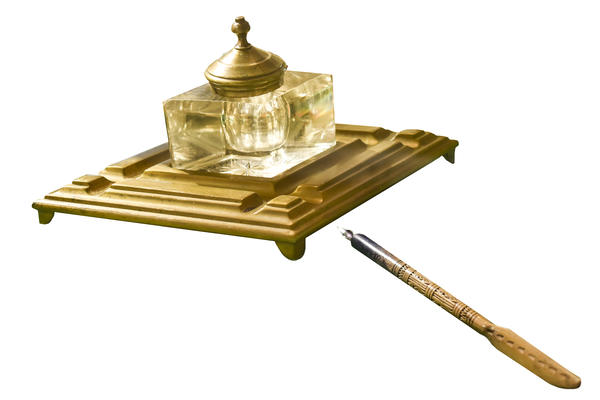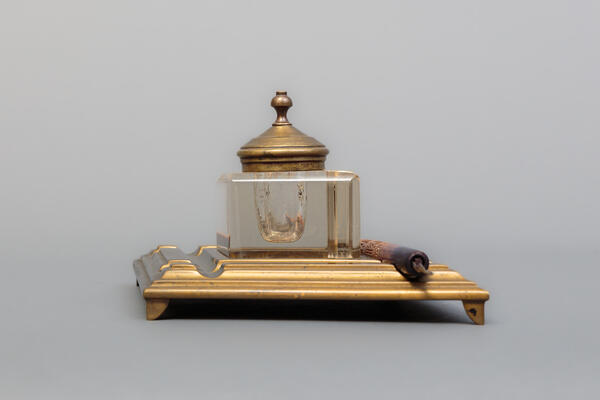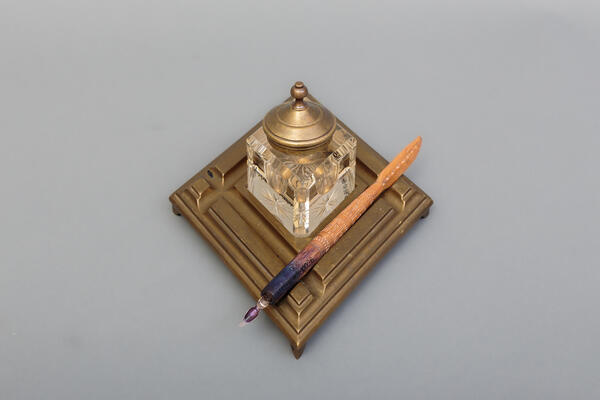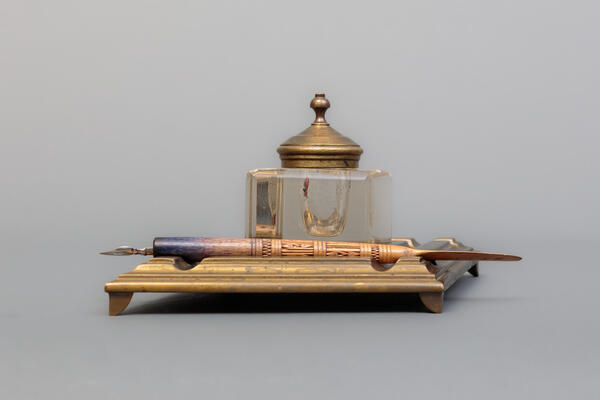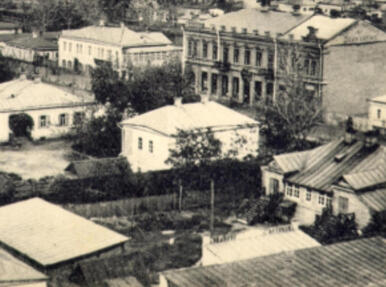People started using ink around the same time they invented a suitable medium for it — papyrus and parchment. A variety of natural dyes were used to make ink. Egyptians mixed ashes from papyrus roots with cherry and acacia gum, Romans mixed ashes from grape seeds with oil. In China, they made thick ink for writing with a brush from soot, vegetable oil and lye. They also used decoctions of elderberries and blueberries, chestnut and walnut peels, ink sacs of cuttlefish and octopus, excrescences on tree leaves and dried worms.
Ink was poured into a clay cup or horn fixed to a tabletop. Other forms of vessels included special bottles, narrow-necked vials and peculiar shot glasses.
One of the oldest writing utensils archaeologists have found belonged to an Egyptian scribe and included writing sticks, an ink bottle and a “blotting pad” with sand. Excavations at Herculaneum revealed a clay inkpot with remnants of soot ink.
In the 17th century, inkwells made of glass began to be produced in England. They were not very ornate, but very practical. English glassblowers invented a “spill-proof” inkwell with cone-shaped funnel in the neck. When the vessel was tipped, the ink got inside the curved end and would not spill out. Small travelling inkpots with narrow necks could be securely carried even in breast pockets. A complete writing set for travelling was a compact box with a flip-up lid. A spill-proof inkwell was embedded in the bottom of the box, accompanied by a miniature candlestick and a couple of sharpened quills. Fancy, massive utensils occupied a large part of the desk; the simpler ones consisted only of an inkpot and a sand shaker (fine sand was sprinkled on the written text to remove the excess ink).
As time passed, more attention was paid to how the inkwells looked. Porcelain, metal, stone and polymer vessels of various sizes and shapes became available. The writing utensils of wealthy people included inkwells decorated with painting, enamel and semi-precious stones.
Inkwells fell out of use with the advent of fountain pens and later ballpoint pens. But certain examples, especially those by Fabergé and de Mailly, are still valued as expensive museum antiques.
Ink was poured into a clay cup or horn fixed to a tabletop. Other forms of vessels included special bottles, narrow-necked vials and peculiar shot glasses.
One of the oldest writing utensils archaeologists have found belonged to an Egyptian scribe and included writing sticks, an ink bottle and a “blotting pad” with sand. Excavations at Herculaneum revealed a clay inkpot with remnants of soot ink.
In the 17th century, inkwells made of glass began to be produced in England. They were not very ornate, but very practical. English glassblowers invented a “spill-proof” inkwell with cone-shaped funnel in the neck. When the vessel was tipped, the ink got inside the curved end and would not spill out. Small travelling inkpots with narrow necks could be securely carried even in breast pockets. A complete writing set for travelling was a compact box with a flip-up lid. A spill-proof inkwell was embedded in the bottom of the box, accompanied by a miniature candlestick and a couple of sharpened quills. Fancy, massive utensils occupied a large part of the desk; the simpler ones consisted only of an inkpot and a sand shaker (fine sand was sprinkled on the written text to remove the excess ink).
As time passed, more attention was paid to how the inkwells looked. Porcelain, metal, stone and polymer vessels of various sizes and shapes became available. The writing utensils of wealthy people included inkwells decorated with painting, enamel and semi-precious stones.
Inkwells fell out of use with the advent of fountain pens and later ballpoint pens. But certain examples, especially those by Fabergé and de Mailly, are still valued as expensive museum antiques.

